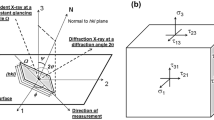Abstract
A new technique has been developed to determine both the transmitted and the reflected stress-optical constants. The reflected optical constant is associated with the light reflected from the rear face of a transparent material. The stress-optical constant related to the light reflected from the front surface is not considered in this paper since it is equal to Poisson's ratio divided by Young's modulus. In this new method, a monochromatic light beam emitted from a He−Ne laser impinges on the area surrounding a circular hole under load in a plate. A digital image-analysis system, EYE-COM III, is used to determine the points of the highest light intensity of the caustic that results from the light transmitted or reflected from the rear face of the plate. The effect of the hole size in optically isotropic materials is investigated.
Similar content being viewed by others
References
Beinert, J. andKalthoff, J.F., “Experimental Determination of Dynamic Stress Intensity Factors by Shadow Patterns,”Mechanics of Fracture,VIII,ed. G.C. Sih,Martinus Nijhoff Publishers,The Hague, The Netherlands (1981).
Theocaris, P.S., “Reflected Shadow Method for the Study of Constrained Zones in Cracked Plates,”J. Appl. Optics,10,2240–2247, (1971).
Younis, N.T. and Zachary, L.W., “A Nonlinear Least-Squares Method for the Determination of Mixed Mode Stress Intensity Factors Using the Experimental Method of Caustics,” Proc. 1987 SEM Spring Conf. on Exp. Mech. (1987).
Stamatios, V. Kartalopoulos andRaftopoulos, Demetrios D., “A Rapid Optical Method for the Determination of Stress-Optical Constants of Optically Isotropic and Anisotropic Materials,”J. Appl. Phys.,9,2545–2553 (1976).
Theocaris, P.S. andPrassianakis, J., “Interrelation of Mechanical and Optical Properties of Plasticized Epoxy Polymers,”J. Appl. Pol. Sci.,22,1725–1734 (1978).
Dally, J.W. andRiley, W.F., Experimental Stress Analysis, 2nd Ed., McGraw-Hill, New York (1978).
Kamath, S.M. andKim, K.S., “Coherent Light-Shadow Spot of a Crack Under Mode I Loading: Theory and Experiment,Experimental Mechanics,26, (4),386–393 (1986).
Theocaris, P.S., “Elastic Stress Intensity Factors Evaluated by Caustics,”Mechanics of Fracture,VII,ed. G.C. Sih,Martinus Nijhoff Publishers,The Hague, The Netherlands (1981).
Prassianakis, J.N. andTheocaris, P.S., “Stress Intensity Factors at V-Notched Elastic, Symmetrically Loaded Plates by the Method of Caustics,”J. Phys. D: Appl. Phys.,13,1043–1053 (1980).
Author information
Authors and Affiliations
Rights and permissions
About this article
Cite this article
Younis, N.T., Zachary, L.W. A new technique for the determination of stress-optical constants using the shadow spot method. Experimental Mechanics 29, 75–79 (1989). https://doi.org/10.1007/BF02327785
Received:
Accepted:
Issue Date:
DOI: https://doi.org/10.1007/BF02327785




